
A turboprop is a turbine engine that drives an aircraft propeller.

Takeoff is the phase of flight in which an aerospace vehicle leaves the ground and becomes airborne. For aircraft traveling vertically, this is known as liftoff.

A tachometer is an instrument measuring the rotation speed of a shaft or disk, as in a motor or other machine. The device usually displays the revolutions per minute (RPM) on a calibrated analogue dial, but digital displays are increasingly common.
Aviation is the design, development, production, operation, and use of aircraft, especially heavier-than-air aircraft. Articles related to aviation include:

The airspeed indicator (ASI) or airspeed gauge is a flight instrument indicating the airspeed of an aircraft in kilometres per hour (km/h), knots, miles per hour (MPH) and/or metres per second (m/s). The recommendation by ICAO is to use km/h, however knots (kt) is currently the most used unit. The ASI measures the pressure differential between static pressure from the static port, and total pressure from the pitot tube. This difference in pressure is registered with the ASI pointer on the face of the instrument.
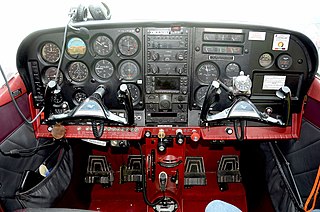
Aircraft engine controls provide a means for the pilot to control and monitor the operation of the aircraft's powerplant. This article describes controls used with a basic internal-combustion engine driving a propeller. Some optional or more advanced configurations are described at the end of the article. Jet turbine engines use different operating principles and have their own sets of controls and sensors.
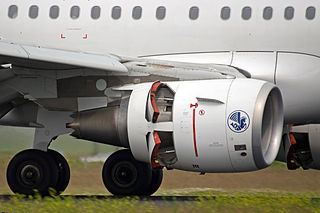
Thrust reversal, also called reverse thrust, is the temporary diversion of an aircraft engine's thrust for it to act against the forward travel of the aircraft, providing deceleration. Thrust reverser systems are featured on many jet aircraft to help slow down just after touch-down, reducing wear on the brakes and enabling shorter landing distances. Such devices affect the aircraft significantly and are considered important for safe operations by airlines. There have been accidents involving thrust reversal systems, including fatal ones.
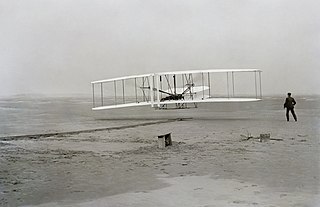
In aeronautical and naval engineering, pusher configuration is the term used to describe a drivetrain of air- or watercraft with propulsion device(s) after the engine(s). This is in contrast to the more conventional tractor configuration, which places them in front.
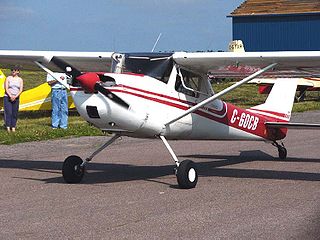
Conventional landing gear, or tailwheel-type landing gear, is an aircraft undercarriage consisting of two main wheels forward of the center of gravity and a small wheel or skid to support the tail. The term taildragger is also used.
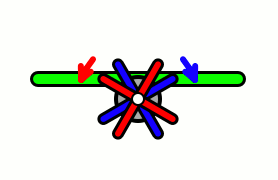
Aircraft equipped with contra-rotating propellers (CRP) coaxial contra-rotating propellers, or high-speed propellers, apply the maximum power of usually a single piston engine or turboprop engine to drive a pair of coaxial propellers in contra-rotation. Two propellers are arranged one behind the other, and power is transferred from the engine via a planetary gear or spur gear transmission. Contra-rotating propellers are also known as counter-rotating propellers, although the term counter-rotating propellers is much more widely used when referring to airscrews on separate non-coaxial shafts turning in opposite directions.

The Aero Boero AB-115 is an Argentine civil utility aircraft. It was developed from the AB-95-115, a refined AB-95 with a more powerful engine and improved aerodynamics. Specific differences included wheel spats, a redesigned engine cowling molded of fiberglass, and aluminum ailerons and flaps.

The Cessna 175 is a light four-seat, single-engine, fixed wing aircraft produced by Cessna between 1958 and 1962. A deluxe model known as the Skylark was introduced in 1960. The aircraft is similar to the popular Cessna 172 but has higher gross weight and a more powerful engine with a geared reduction drive.

The Learjet 25 is an American ten-seat, twin-engine, high-speed business jet aircraft manufactured by Learjet. It is a stretched version of the Learjet 24.

In aeronautics, a variable-pitch propeller is a type of propeller (airscrew) with blades that can be rotated around their long axis to change the blade pitch. A controllable-pitch propeller is one where the pitch is controlled manually by the pilot. Alternatively, a constant-speed propeller is one where the pilot sets the desired engine speed (RPM), and the blade pitch is controlled automatically without the pilot's intervention so that the rotational speed remains constant. The device which controls the propeller pitch and thus speed is called a propeller governor or constant speed unit.
A takeoff/go-around switch is a switch on the autothrottle of modern large aircraft, with two modes: takeoff (TO) and go-around (GA). The mode is dependent on the phase of flight; usually, on approach to land, the autopilot will be set to approach mode, therefore if the TO/GA switch is pressed it will activate the go-around mode of the autothrottle (about 90–92% N1, if pressed again, go around thrust will increase to full ; conversely, when takeoff is set on the autopilot, the switch activates takeoff mode of the autothrottle. On Boeing aircraft, TO/GA modes are selected by a separate button near the throttle levers; on Airbus aircraft, it is activated by advancing the thrust levers forward to the TO/GA detent.

The UTVA 75 is a light utility aircraft produced by the Serbian aircraft manufacturer UTVA. It was first introduced in the late 1970s and has since been used primarily for training, reconnaissance, and light transport roles. Known for its reliability and versatility, the UTVA 75 has been adopted by several military and civilian operators around the world.

In aeronautics, an aircraft propeller, also called an airscrew, converts rotary motion from an engine or other power source into a swirling slipstream which pushes the propeller forwards or backwards. It comprises a rotating power-driven hub, to which are attached several radial airfoil-section blades such that the whole assembly rotates about a longitudinal axis. The blade pitch may be fixed, manually variable to a few set positions, or of the automatically variable "constant-speed" type.

A turbine engine failure occurs when a gas turbine engine unexpectedly stops producing power due to a malfunction other than fuel exhaustion. It often applies for aircraft, but other turbine engines can also fail, such as ground-based turbines used in power plants or combined diesel and gas vessels and vehicles.
Engine failure on takeoff (EFTO) is a situation, when flying an aircraft, where an engine has failed, or is not delivering sufficient power, at any time between brake release and the wheels leaving the ground / V2. The phases of flight are delineated to allow simplified standard procedures for different aircraft types to be developed. If an aircraft suffered engine failure on takeoff, the standard procedure for most aircraft would be to abort the takeoff.

The Fahlin SF-2 Plymocoupe was a high-wing, cantilever type, prototype experimental airplane produced in 1935.
















